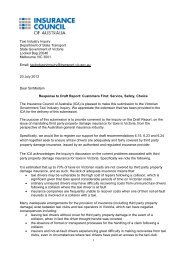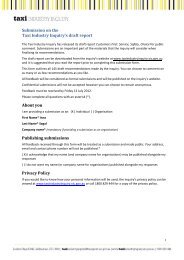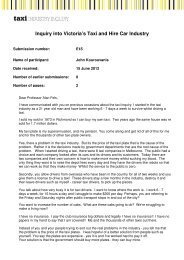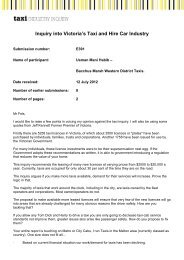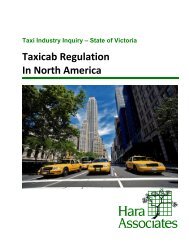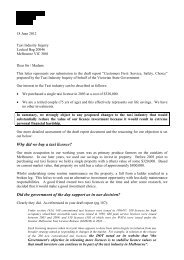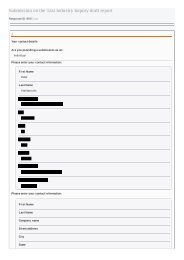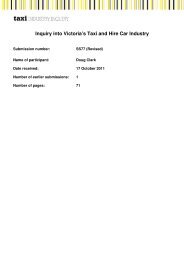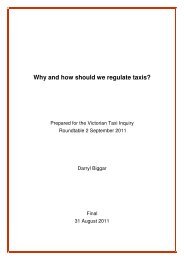Part D â Understanding and improving industry performance (PDF ...
Part D â Understanding and improving industry performance (PDF ...
Part D â Understanding and improving industry performance (PDF ...
Create successful ePaper yourself
Turn your PDF publications into a flip-book with our unique Google optimized e-Paper software.
In restrictive markets, the regulator is usually highly<br />
prescriptive when enforcing taxi regulations <strong>and</strong><br />
monitoring taxi services. This is not surprising, as<br />
restrictive taxi market schemes naturally result from<br />
government intervention. For example, the role of<br />
government in the more restrictive markets, such as New<br />
York City <strong>and</strong> other Australian States <strong>and</strong> Territories, is to<br />
control the number of licences via licensing regimes, set<br />
fares <strong>and</strong> prescribe quality <strong>and</strong> safety st<strong>and</strong>ards.<br />
Even in less restrictive markets, specifically those with<br />
deregulated entry restrictions, governments still play<br />
a role in regulating the taxi <strong>industry</strong>. However, the role<br />
of government in these regimes is less focused on<br />
regulating the ‘static’ taxi parameters, such as quantity<br />
<strong>and</strong> fare controls, <strong>and</strong> more focused on regulating<br />
quality <strong>and</strong> safety outcomes. A distinction can be made<br />
between quality <strong>and</strong> safety outcomes <strong>and</strong> quality <strong>and</strong><br />
safety st<strong>and</strong>ards. St<strong>and</strong>ards can be highly prescriptive,<br />
particularly in relation to vehicles, <strong>and</strong> may cover such<br />
things as vehicle types, size <strong>and</strong> age. These st<strong>and</strong>ards<br />
are very common in restricted taxi markets that maintain<br />
quantity controls. Outcomes can be thought of as<br />
something broader, where the specifics of the services<br />
<strong>and</strong> safety controls are left to the <strong>industry</strong> participants,<br />
with only broad quality <strong>and</strong> safety outcomes guided by<br />
the regulator.<br />
The open entry taxi markets of New Zeal<strong>and</strong> <strong>and</strong><br />
Singapore maintain a role for government in the form of<br />
setting outcome-focused service st<strong>and</strong>ards for booking<br />
networks companies, while at the same time providing<br />
greater scope for competition between networks – such<br />
as allowing the networks to differentiate their services:<br />
for example, ‘environmentally friendly’ taxis in New<br />
Zeal<strong>and</strong>. 22 The actual quantity parameters, such as<br />
supply of taxis at particular times <strong>and</strong> fares, are mostly<br />
left up to the <strong>industry</strong> participants.<br />
In contrast, New York, which maintains controls on the<br />
number of taxi vehicles available, has also m<strong>and</strong>ated the<br />
type of vehicle that can be a taxi. The New York Taxi <strong>and</strong><br />
Limousine Commission (TLC) has announced that the<br />
Nissan NV200 minivan will be the new official taxi in New<br />
York, with current taxis to be phased out by 2018. 23<br />
It is not always clear how jurisdictions have arrived at<br />
the split of regulation between the relevant government<br />
authority <strong>and</strong> <strong>industry</strong> itself to achieve positive<br />
<strong>performance</strong> outcomes.<br />
9.4.4. Higher than expected entry<br />
In markets that have removed entry controls, entry<br />
has usually been much greater than anticipated at<br />
the time of the entry relaxation.<br />
In all jurisdictions where entry restrictions have been<br />
removed, the number of taxi vehicles increased,<br />
sometimes more than expected by the government of the<br />
day. The possible reasons for this are outlined below:<br />
One probable explanation is that there was a significant<br />
level of unmet dem<strong>and</strong> prior to deregulation. However,<br />
it has been difficult for the inquiry to establish this by<br />
solid evidence relating to pre- <strong>and</strong> post-liberalisation trip<br />
numbers. The inquiry found no studies of liberalisation<br />
that were able to accurately measure the change in the<br />
total number of trips following the move to open entry<br />
– there was simply no reliable data on any changes in<br />
consumer dem<strong>and</strong> post-liberalisation. While an Irish<br />
report found that liberalisation of licences resulted in an<br />
82 per cent increase in trips in Dublin between 1997<br />
<strong>and</strong> 2008, this is based only on survey data from Dublin<br />
households rather than actual trip data. 24 Other studies<br />
on jurisdictions that have deregulated are also lacking in<br />
reliable information in this respect. 25<br />
However, there is a strong expectation that the<br />
number of taxi licences issued by government in a<br />
closed entry market is not optimal. Indeed, the effects<br />
of quantity entry restrictions is that they prevent<br />
entry that otherwise would occur in an open entry<br />
market. In doing so, the inquiry expects that some<br />
trips that would be covered at times of peak dem<strong>and</strong><br />
are not covered under a quantity entry regime.<br />
Some studies have reported a decline in productivity<br />
or vehicle utilisation <strong>and</strong> have implied that consumer<br />
dem<strong>and</strong> did not increase following deregulation. 26<br />
However, a drop in vehicle utilisation does not necessarily<br />
mean that consumer dem<strong>and</strong> did not increase as a result<br />
of greater taxi availability. It may be that the increase in<br />
entry was such that it dampened any indications that<br />
dem<strong>and</strong> increased: that is, the percentage increase in<br />
taxi numbers may have been more than the percentage<br />
increase in consumer dem<strong>and</strong> – this will result in an<br />
observed decrease in productivity, at least in the short<br />
term. Indeed, increases in fares may have diminished<br />
some increases in consumer dem<strong>and</strong>.<br />
22 Green Cabs, accessed at: www.greencabs.co.nz/<br />
23 Chapter 15 includes a description of the process adopted by New<br />
York to decide on its new taxi vehicle<br />
24 Goodbody Economic Consultants (2009), Economic review of the<br />
small public service vehicle <strong>industry</strong>, Commission for Taxi Regulation,<br />
Irel<strong>and</strong>, p.18<br />
25 For example, the OECD reported that, following deregulation in the<br />
Netherl<strong>and</strong>s, trips had fallen but passenger kilometres had risen. The<br />
inquiry finds this outcome incongruous. See OECD (2007), Op. Cit.<br />
26 Kang, Choong-Ho (1998), Taxi deregulation: International comparison,<br />
Dissertation, University of Leeds, accessed 29 March 2012 at: www.<br />
taxi-library.org/kang0898.htm<br />
170





